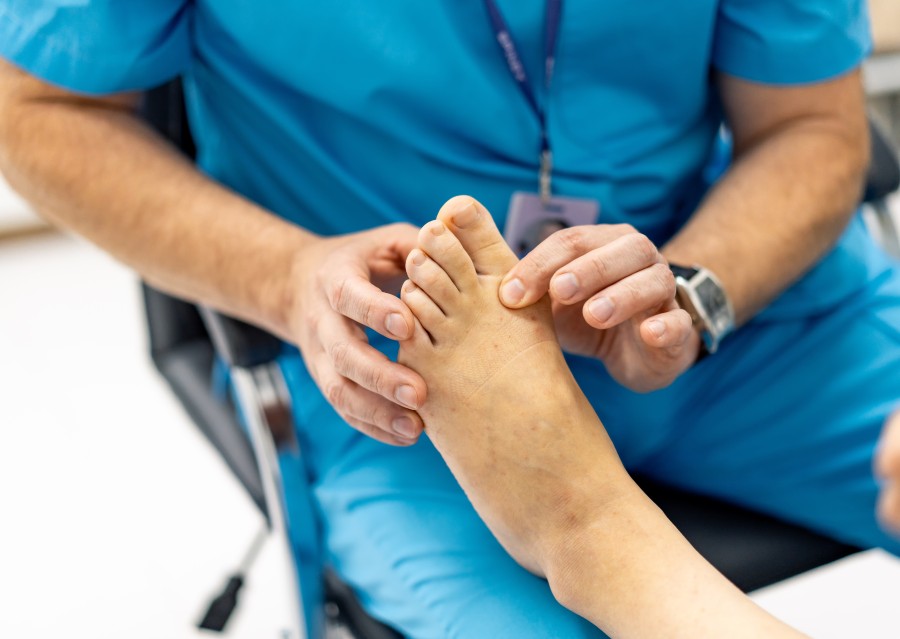Diabetic neuropathy: Causes, symptoms and prevention

Diabetic neuropathy: Causes, symptoms and prevention
Diabetic neuropathy is nerve damage caused by diabetes [1, 2]. It can affect lots of different types of nerves in your body, and can cause a range of problems which can affect your day-to-day life [1, 3].
But what is diabetic neuropathy exactly? And what can you do to prevent it? Are there any signs and symptoms that you should look out for? And can you treat or reverse diabetic neuropathy? Let’s take a closer look.
What is diabetic neuropathy?
Your nervous system is responsible for passing on information (for example, things you taste, touch, or feel) from your body to your central nervous system (the brain and spinal cord) and back again [4]. When the nerves and nervous system are damaged, this information is not transmitted properly, which causes certain symptoms.
Diabetic neuropathy is damage to the nervous system caused by diabetes [4].
Diabetic neuropathy can be acute — meaning it goes away on its own after a few weeks — or chronic and long-lasting [1].
Neuropathy can be caused by both type 1 and type 2 diabetes [1, 2].
Types of diabetic neuropathy
Nerve damage from diabetes can cause all sorts of conditions and complications, involving different types of nerves and processes in the body [2]. We’ve covered some of the main types of diabetic neuropathy below.
Diabetic peripheral neuropathy
Peripheral neuropathy refers to damage to the peripheral nervous system — a vast communications network that sends messages between the central nervous system (the brain and spinal cord) and all other parts of the body [4].
There are different types of diabetic peripheral neuropathy, such as sensory, motor and autonomic [3].
Sensory neuropathy

Sensory neuropathy
Sensory neuropathy affects the nerve fibres that help you touch and feel things [2]. Sensory neuropathy can cause you to lose your sense of touch, temperature, pain and other sensations, and result in numbness or tingling [1, 3, 4]. It commonly affects the feet and hands [1, 3].
About 20% of people with diabetes will have pain from sensory neuropathy, which can feel like a pricking or burning feeling [2].
Motor neuropathy
Motor neuropathy affects motor nerve fibres, which are in charge of movement and muscle control [1, 4]. Motor neuropathy can lead to muscle weakness, muscle wasting [1] and sometimes deformities [3].
Autonomic neuropathy
Autonomic neuropathy affects the nerves that control organs and activities that we don’t manage consciously — such as breathing, digesting food, and heart and gland functions [4].
Autonomic neuropathy can affect almost every organ in the body, particularly the genitourinary tract, the skin, the sweat glands, the gastrointestinal tract and the cardiovascular system [1].
Because it can affect lots of different organs, it can cause lots of different issues. For example, it can cause fast or irregular heartbeat, high blood pressure, diarrhoea, constipation, loss of bowel or bladder control, dry skin or erectile dysfunction [1].
Focal neuropathy
This type of neuropathy affects individual nerves and nerve roots [2]. Focal neuropathies can affect the nerves in your head, including the oculomotor nerve (which controls eye movement), the nerves in the chest, or other singular nerves in the arms, hands, or feet [2].
Focal neuropathies are usually painful, but they tend to go away on their own in 6–8 weeks [1].
What causes diabetic neuropathy?
Several factors can cause diabetic neuropathy [3].
In both type 1 and 2 diabetes, having high blood glucose levels over long periods of time can damage the small blood vessels in your body [1, 3]. These tiny blood vessels are responsible for delivering nutrients and oxygen to your nerves, so any damage to them can cause damage to your nervous system [3].
Other factors that may increase your risk of developing neuropathy include [3]:
- High levels of fats in the blood (dyslipidemia)
- High blood pressure
- Older age
- Smoking
- Chronic alcohol use
- Certain genes
How long does diabetic neuropathy take to develop?
Diabetic neuropathy develops gradually, and the risk increases the longer you have diabetes [3]. How long it takes for the neuropathy to progress depends on the type that you have [2]. For example, some rare forms of neuropathy may take days or weeks to develop, while others can take months or years [2].
Diabetic neuropathy symptoms
The signs and symptoms of diabetic neuropathy can vary depending on the type of neuropathy you have and the nerves that are damaged. Many people often do not notice that they have the condition, so it’s important to know the symptoms and check with your doctor if you’re worried [1].
Overall, symptoms of diabetic neuropathy tend to affect the hands, feet, legs and arms. They can include the following [1, 3]:
- Numbness, tingling, prickling and/or burning sensations that start in the toes and then extend further, or that get worse at night [1, 3]
- An inability to feel hot and cold temperatures normally [1]
- Decreased sweating [1]
- Feeling like you’re walking on cotton or like the floor feels strange [1]
- Difficulty walking or going about daily activities as a result of the above sensations in the feet [1]
- Pain which can be deep, aching, severe or stabbing [1]
Dry, cracked skin may be a sign of autonomic neuropathy [3], while motor neuropathy can cause [1, 3]:
- Loss of balance
- The inability to stand on your toes or heels
- Foot deformities
Finally, autonomic neuropathy can cause various symptoms depending on the organ it affects. The symptoms can range from heat intolerance to fainting [1, 3].
Complications: what problems does diabetic neuropathy cause?
Diabetic neuropathy often leads to poor quality of life, anxiety, depression and a range of other health problems if it’s not well managed [3].
If left untreated, peripheral diabetic neuropathy can cause [3]:
- Foot ulcers
- Infections of the foot or infections that affect the entire body
- Dizziness and a higher risk of falls
- A higher risk of injury because you cannot feel your feet
- Amputation of the affected limbs, such as of the toes, feet or legs
- Sepsis (septicaemia)
- Cardiovascular neuropathy (which can be fatal)
To learn more about how to look after your feet when you have diabetes and prevent diabetic foot complications, read our dedicated article on diabetes and foot health.
Diabetic neuropathy: diagnosis
To accurately diagnose neuropathy, your doctor will ask you a series of questions as part of a thorough clinical examination [1]. The examination might include [1]:
- Examining your feet for any signs of calluses, ulcers, or foot deformities
- Testing your foot and ankle reflexes
- Testing your ability to tell the difference between hot and cold temperatures using a non-invasive device
- Testing how much sweat your sweat glands produce by using a small patch that is attached to your foot
- Testing your ability to feel touch and vibration
Your doctor may also use digital photography of your retina to check for diabetic retinopathy, blood and urine tests to test for diabetic kidney disease, or cardiovascular reflex tests to test for autonomic neuropathy [1].
Diabetic neuropathy treatment

Diabetic neuropathy treatment
Detecting neuropathy as early as possible is key [1]. Early intervention can help you improve your blood glucose levels, which may in turn help reduce neuropathy symptoms and prevent further complications [1, 4].
How to manage diabetic neuropathic pain
If you have a painful form of neuropathy, ask your doctor about medication options. Several medications might be used to ease nerve damage pain [1, 4].
Some of these medicines are also used for treating other health conditions such as depression, epilepsy or anxiety, but they can still be recommended to manage nerve pain. For example, some medications that we know as antidepressants help with chronic neuropathic pain by increasing the brain's ability to inhibit incoming pain signals [4].
Other management techniques that you may find helpful include [1, 3]:
- Cold water immersion
- Wearing silk pyjamas to ease nerve pain
- Wearing comfortable footwear
- Physiotherapy to help manage muscle pain and weakness
Other therapies, such as acupuncture and electrical nerve stimulation, have shown benefits in some clinical trials [1].
Finally, receiving support for your mental health can go a long way in helping you manage neuropathic pain [1].
Can diabetic neuropathy be reversed?
Usually, diabetic neuropathy cannot be reversed once it has been diagnosed [1]. This is because, by the time diagnostic tests can pick up neuropathy, it is already well established — meaning the nerve damage has already happened, and can’t be undone [1].
Still, it is worth noting that a handful of studies suggest lifestyle changes, such as regular exercise and a healthy diet, may be able to help with some of the effects of nerve damage [1].
How can you prevent diabetic neuropathy?
Keeping your blood glucose levels within your target range is essential for preventing diabetic neuropathy [3].
Your doctor and healthcare team will advise you on what steps to take to manage your blood glucose, including [3]:
- Taking your diabetes medication or insulin on time
- Testing and monitoring your blood glucose levels regularly
- Following a balanced diet
- Limiting alcohol
- Quitting smoking
- Exercising
- Losing weight if necessary
To read more about blood glucose levels and how to manage them, read our article on monitoring blood glucose. You can also check out our guide on how to keep blood glucose within target.
Lowering your lipid levels (blood fats) and your blood pressure can also help prevent some forms of diabetic neuropathy [1, 3].
Feet are especially at risk of diabetic neuropathy [3]. Your doctor should complete a foot check-up regularly and show you how to examine your feet yourself and look for signs of ulcers, wounds or broken skin every day [3]. They may also refer you to a podiatrist (a foot specialist) for extra care and prevention [3].
Diabetic neuropathy can be a complication of diabetes — and the problems that nerve damage may cause can be serious [1]. However, keeping your blood glucose levels within your target range can help protect your nerves and prevent diabetic neuropathy [1]. Learn how to recognise the early signs and symptoms, see your diabetes care team for screening every year, and speak to your doctor or care team for advice if you think you’re developing any signs of neuropathy [1].
Sources:
- Anandhanarayanan A, Teh K, Goonoo M, et al. Diabetic Neuropathies. [Updated 2022 Mar 15]. In: Feingold KR, Anawalt B, Blackman MR, et al., editors. Endotext [Internet]. South Dartmouth (MA): MDText.com, Inc.; 2000-. Available from: https://www.ncbi.nlm.nih.gov/books/NBK279175/
- lbers, J. W., & Pop-Busui, R. (2014). Diabetic neuropathy: mechanisms, emerging treatments, and subtypes. Current neurology and neuroscience reports, 14(8), 473. https://doi.org/10.1007/s11910-014-0473-5
- Bodman MA, Varacallo M. Peripheral Diabetic Neuropathy. [Updated 2022 Sep 29]. In: StatPearls [Internet]. Treasure Island (FL): StatPearls Publishing; 2023 Jan-. Available from: https://www.ncbi.nlm.nih.gov/books/NBK442009/
- NIH National Institute of Neurological Disorders and Stroke, Peripheral neuropathy, Accessed April 11, 2023, Available at: https://www.ninds.nih.gov/health-information/disorders/peripheral-neuropathy

